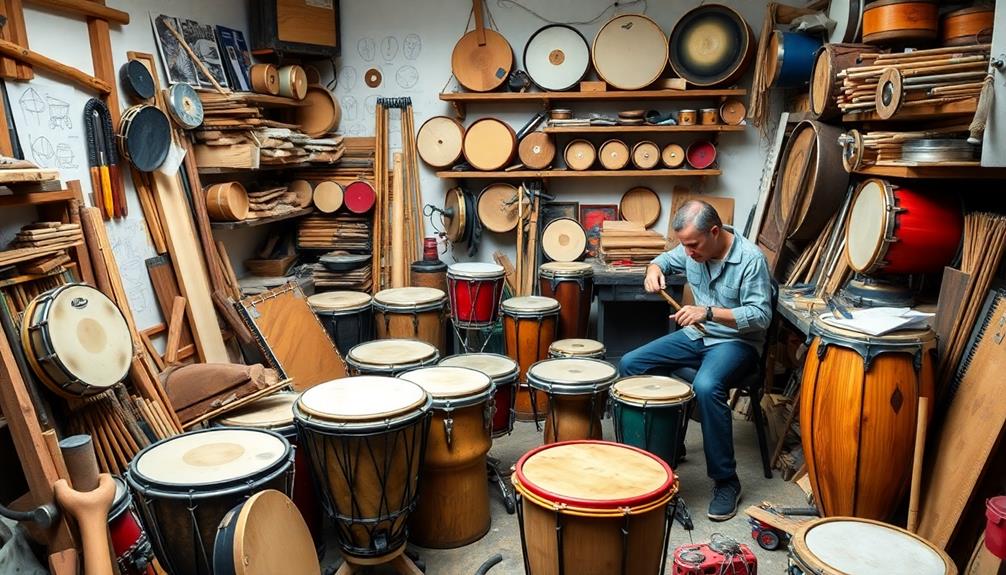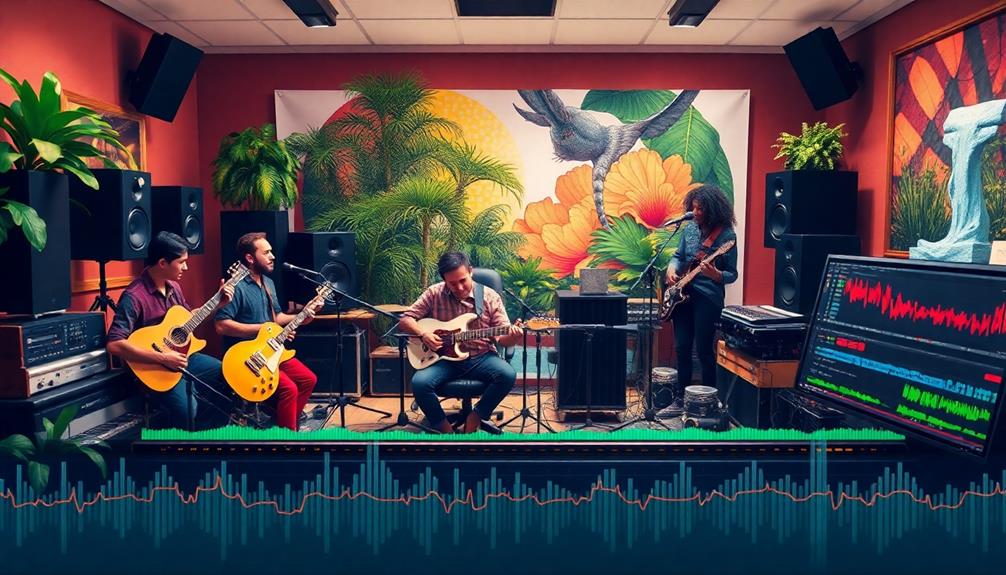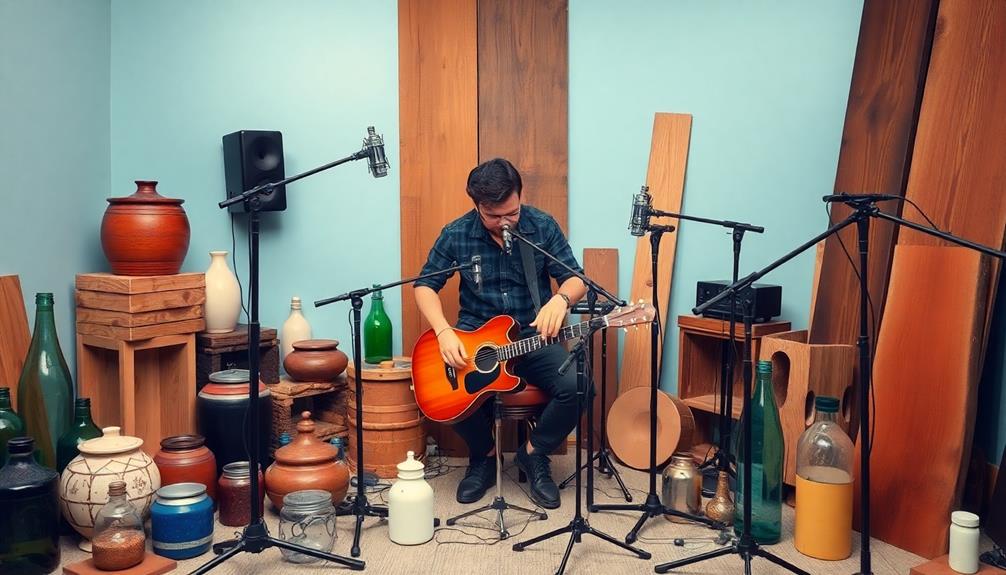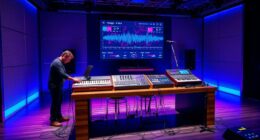You can turn the ordinary into the extraordinary by exploring unique sound sources. Capture sounds from nature or urban life with your smartphone, or use everyday objects like creaking doors for rhythmic patterns. Manipulate your samples through techniques like granular synthesis or pitch-shifting to enrich your music. Layer organic and electronic sounds for a cohesive mix, and don't forget about effects like reverb to enhance presence. With a little experimentation, you can create immersive soundscapes that resonate emotionally. Stick around, and you'll discover even more innovative techniques to elevate your compositions!
Key Takeaways
- Explore field recordings from nature and urban settings to capture unique sonic textures for your compositions.
- Utilize everyday objects like creaking doors and rustling paper to create innovative rhythmic patterns.
- Experiment with granular synthesis to transform samples into lush pads and intricate rhythms.
- Layer organic and electronic samples to create a cohesive and engaging sound experience.
- Take advantage of smartphone technology for spontaneous and high-quality sound capture in diverse environments.
Unique Sound Sources to Explore

When you plunge into the world of unique sound sources, you'll discover that inspiration often lies just outside your door or even in your own home. Field recordings from nature or urban settings can provide extraordinary sonic textures that enhance your music's atmosphere.
Just think about the creaking of a door or the rustle of paper; these everyday objects can create enchanting rhythmic patterns and serve as innovative sampling fodder. Additionally, consider the impact of AI-powered virtual reality in e-learning that can enhance your understanding of sound design through immersive experiences.
Don't overlook vintage vinyl and thrift store finds, either. You might stumble upon hidden audio treasures perfect for creative sampling and manipulation. Websites like Freesound.org also offer vast libraries of user-contributed samples, allowing you to explore diverse sound textures from around the globe.
Innovative sampling often means stepping beyond conventional sources. Incorporating ambient and unmusical samples, like famous quotes or sounds from public spaces, can add depth and character to your tracks.
Innovative Field Recording Techniques
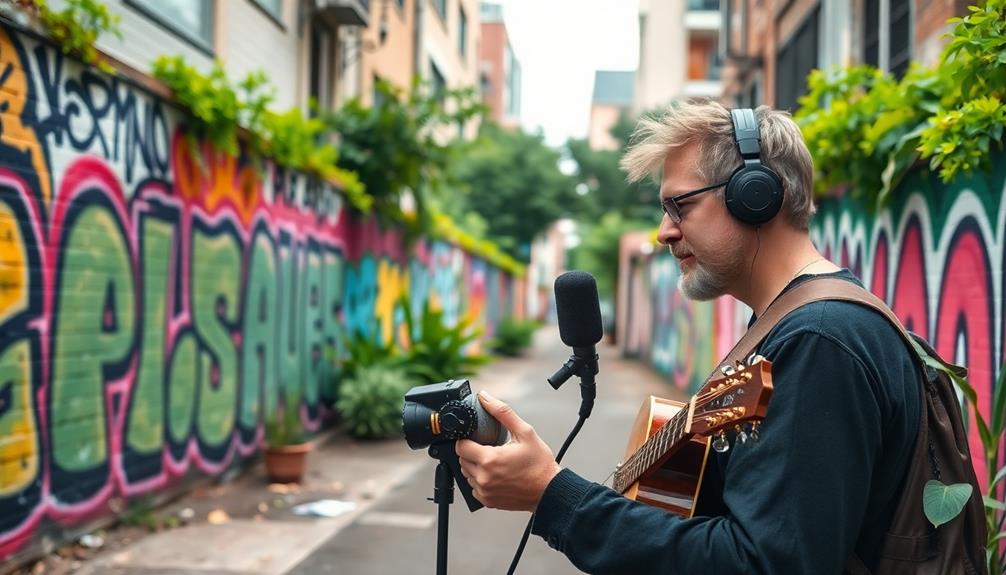
With the right approach, innovative field recording techniques can transform your musical landscape. You don't need specialized equipment; your smartphone can easily capture high-quality sounds from diverse environments.
For instance, while camping, you can embrace the sounds of nature, like waterproofing pop-up camper canvas, which can provide a serene backdrop for your recordings. Explore locations like forests, lakes, and urban settings to gather ordinary sounds, such as birdsong or the rustle of leaves. These ambient sounds can enhance the emotional depth of your music.
Don't overlook everyday objects around you! Items like creaking doors or kitchen utensils can serve as unique sound sources, providing percussion sounds and textures that add character to your compositions.
Look at how artists like Fred Again use voice notes and social media clips to shape their musical identity with relatable audio snippets.
To really elevate your field recordings, experiment with different microphone placements and alternative recording methods. You'll often capture unexpected audio gems that can inspire creative sampling projects.
Creative Sample Manipulation Methods

Building on the rich textures you've captured through innovative field recording techniques, creative sample manipulation methods can take your music to another level. By experimenting with advanced sampling techniques, you can transform ordinary sounds into something truly extraordinary.
To enhance your creative process, consider optimizing your music production workflow with well-structured methods that allow for seamless integration of samples.
- Immerse yourself in granular synthesis to break down samples into tiny segments, allowing you to create lush pads or intricate rhythmic elements.
- Use pitch-shifting to layer original samples with their altered versions, enriching your harmonic textures and creating enchanting melodic phrases.
- Explore time-stretching techniques to discover new rhythmic possibilities, whether you're slowing things down or speeding them up without losing character.
Layering multiple samples not only adds depth but also encourages you to experiment with complementary sounds, effects, and panning. Each manipulation reveals new dimensions in your music, inviting you to set free your imagination.
Chop and slice your samples for precise control, rearranging them to fit your vision or to inject rhythmic excitement. With these methods at your disposal, you'll find that the ordinary can become extraordinary, and your creative potential is limitless.
Effective Sample Integration Strategies
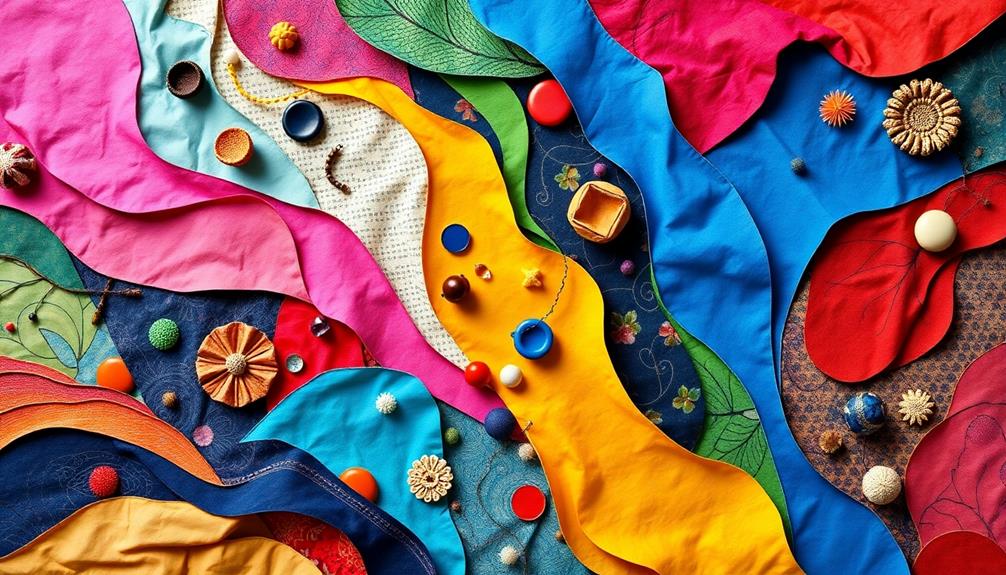
Integrating samples effectively requires a keen understanding of context and mood, as the right choices can evoke powerful emotions and enhance your track's narrative. To achieve this, consider incorporating various sampling techniques that allow your sounds to shine.
Start by layering samples. Combining vocal snippets with environmental sounds adds depth and richness, creating a more immersive listening experience. You can also blend organic samples from field recordings with electronic elements to produce a cohesive sound, bridging natural and synthetic textures.
The arrangement and mixing of your samples are essential for sonic unity. Make certain different elements complement each other rather than clash. Utilizing effects like reverb and delay on your integrated samples can further enhance their presence in the mix, creating a seamless blend that engages listeners.
Here's a quick overview of effective integration strategies:
| Technique | Description |
|---|---|
| Layering | Combine multiple samples for depth |
| Blending | Merge organic and electronic sounds |
| Arranging | Guarantee harmony between elements |
The Future of Creative Sampling

As you explore the landscape of creative sampling, the future promises even more exciting possibilities. The evolution of sound is reshaping how you approach sampling, pushing boundaries and inviting you to turn the ordinary into the extraordinary. By tapping into unconventional sound sources, you'll discover unique samples that elevate your music beyond the traditional.
- Craft immersive soundscapes that resonate emotionally.
- Collaborate with fellow musicians to expand your creative horizons.
- Use DIY methods to capture spontaneous sounds anywhere.
Advancements in technology, such as granular synthesis and real-time manipulation, empower producers like you to create intricate sound designs that captivate audiences. The accessibility of portable recording devices means that free samples are at your fingertips, encouraging you to embrace personalization in your compositions.
As the music production landscape continues to evolve, remember that creative sampling will be essential in exploring new sonic possibilities. Producers who experiment with unique sounds and textures can push the boundaries of what’s possible, creating innovative tracks that stand out. Utilizing song arrangement templates for success can also serve as a valuable starting point, helping streamline workflows while leaving room for artistic freedom. By combining these tools with bold creativity, the potential for shaping groundbreaking music becomes limitless.
Frequently Asked Questions
What Are the 5 Sampling Techniques and Meaning?
You've got five sampling techniques to explore: Chopping and Rearranging for rhythm, Time-Stretching to change tempo, Pitch Shifting for harmonics, Granular Synthesis for texture, and Reversing Samples to create unique audio effects.
How to Sample Creatively?
To sample creatively, explore everyday objects for unique sounds, utilize field recordings for depth, experiment with time-stretching and pitch-shifting, incorporate granular synthesis for intricate textures, and layer samples to enrich your compositions.
Which of the Following 4 Are Types of Sampling Techniques?
When exploring sampling techniques, you'll find chopping, layering, slicing, pitch shifting, and time-stretching are key methods. Each offers unique ways to manipulate sounds and create engaging audio experiences in your music production.
What Are the Four Main Steps of All Sampling Techniques?
When you immerse yourself in sampling techniques, you'll first select diverse sound sources, then capture high-quality audio. Next, you'll process samples creatively and finally layer and arrange them for a cohesive composition.
Conclusion
By embracing these creative sampling techniques, you can transform the ordinary into the extraordinary. Imagine taking the sound of rain falling on a tin roof and morphing it into a haunting melody that defines your next track. Artists like Bon Iver have used field recordings to craft immersive soundscapes, proving that inspiration lies all around you. So, grab your gear and start experimenting—your next masterpiece is just a sample away!


